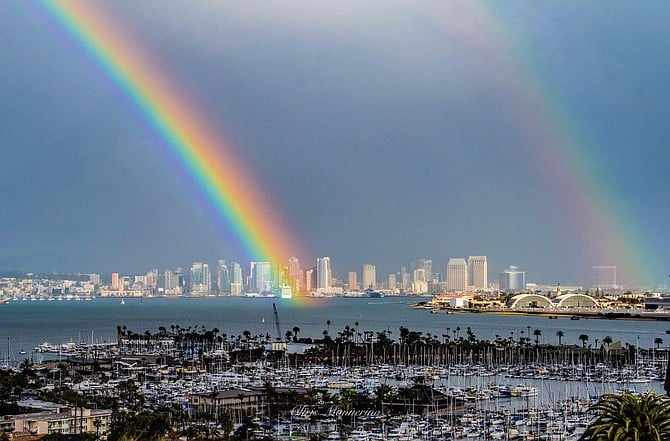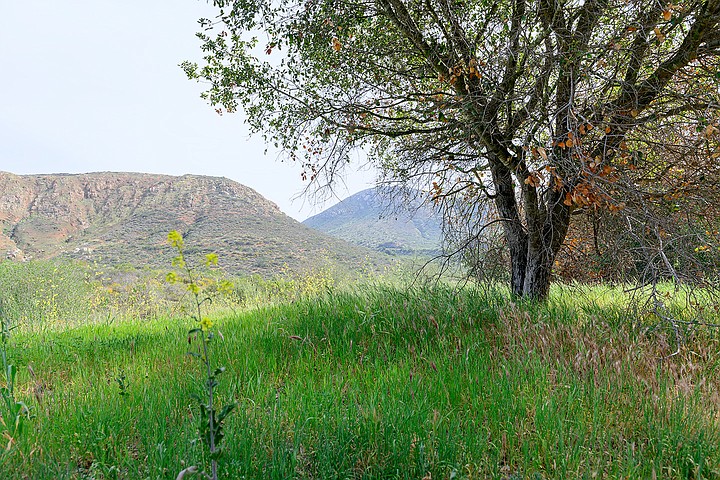 Facebook
Facebook
 X
X
 Instagram
Instagram
 TikTok
TikTok
 Youtube
Youtube

”Rainbow Season” arrives with the first rains of November or December. Scattered showers are best for rainbow watching: sunlight refracting and reflecting through the raindrops causes two bows to appear — an intense circular arc at 42°, and a bigger, but weaker arc at 51° from the antisolar point (the point in the sky diametrically opposed to the sun’s position). From November through mid-February, the sun as seen from San Diego never gets higher than 42° above the horizon, so (rain and sunlight permitting) the brighter of the two arcs may appear above the horizon at any time of day. In spring and summer, rainbows are never seen in the sky around midday because the sun is too high — and the antisolar point is too low.

The Fremont Cottonwoods along the San Diego River in Mission Gorge are now showing off their best autumnal foliage. You can park at the Old Mission Dam historic site or the Mission Trails Regional Park visitor center and explore the riparian area by way of riverside trails, or by walking, bike riding or skating along the bike path high above the river’s south and east banks. Large cottonwoods can also be seen along other watercourses throughout the San Diego County backcountry, including along the Sweetwater River near Cottonwood Golf Course, and in Cottonwood Valley, east of Pine Valley along Interstate 8.

Santa Ana Winds in San Diego County often reach their greatest intensity during November, particularly at the mountain passes, where dry air from a high-pressure area over the interior deserts swoops coastward toward a low-pressure area offshore. The subsiding air warms rapidly while it descends, resulting in 80° to 90° temperatures close to the coast. While passing over the mountains, though, the dry air can be surprisingly cool — 60° or less in the daytime.


”Rainbow Season” arrives with the first rains of November or December. Scattered showers are best for rainbow watching: sunlight refracting and reflecting through the raindrops causes two bows to appear — an intense circular arc at 42°, and a bigger, but weaker arc at 51° from the antisolar point (the point in the sky diametrically opposed to the sun’s position). From November through mid-February, the sun as seen from San Diego never gets higher than 42° above the horizon, so (rain and sunlight permitting) the brighter of the two arcs may appear above the horizon at any time of day. In spring and summer, rainbows are never seen in the sky around midday because the sun is too high — and the antisolar point is too low.

The Fremont Cottonwoods along the San Diego River in Mission Gorge are now showing off their best autumnal foliage. You can park at the Old Mission Dam historic site or the Mission Trails Regional Park visitor center and explore the riparian area by way of riverside trails, or by walking, bike riding or skating along the bike path high above the river’s south and east banks. Large cottonwoods can also be seen along other watercourses throughout the San Diego County backcountry, including along the Sweetwater River near Cottonwood Golf Course, and in Cottonwood Valley, east of Pine Valley along Interstate 8.

Santa Ana Winds in San Diego County often reach their greatest intensity during November, particularly at the mountain passes, where dry air from a high-pressure area over the interior deserts swoops coastward toward a low-pressure area offshore. The subsiding air warms rapidly while it descends, resulting in 80° to 90° temperatures close to the coast. While passing over the mountains, though, the dry air can be surprisingly cool — 60° or less in the daytime.
Comments